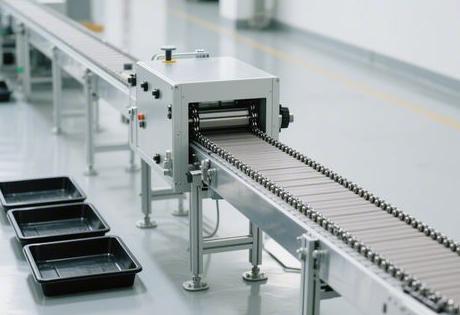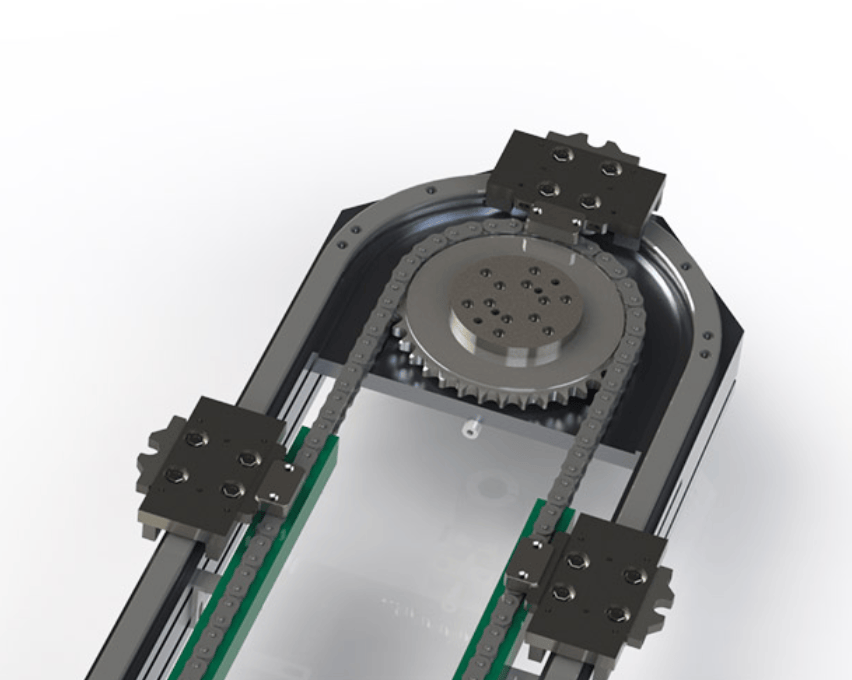I. Core Principles and Innovative Value of Speed Chain Technology
At the heart of the multiplier chain (also known as differential chain) lies the unique"Growth rate effect". When the chain is running at a constant speed, the upper pallets and workpieces can be moved at 2.5-3 times the actual speed of the chain. This feature is due to its mechanical design:

- Roller-roller diameter ratio: The formula for the speed of the work plate is v = v₀ × (1 + D/d)(D is the diameter of the roller, d is the diameter of the roller), the speed increase is achieved by increasing the D/d ratio.
- Friction control mechanisms: Rolling friction between the work plate and the rollers, very low resistance when stopping, allowing the积放功能--When some workpieces are suspended, other workpieces can continue to be conveyed.
personal viewpointThe paradox of "low-speed chain, high-speed conveyor" of the speed multiplier chain reflects the ingenuity of mechanical design. ItBalances efficiency with controllabilityIt is a classic application of physical friction characteristics for mechanical engineers, especially for small production lines that require flexible beat-to-beat adjustment.
II. Structural innovation and spatial optimisation of small up-and-down circulation lines
While traditional speed chains are mostly used in single-level linear layouts, the up-and-down circulation structure significantly improves conveying efficiency in small sites by reusing vertical space:
-
Double closed loop design
- Separation of carrier and return segments: The upper level conveys the material and the lower level returns empty, forming a continuous cycle.
- Compact guidance system: The distance between the upper and lower rails is smaller than the diameter of the sprocket, and it is necessary to configureRotary guide seatAvoid chain snagging, which is the key to space compression.
-
Modular component design
- Elevating transplanting mechanismCylinder drive + guide bar structure for 90° turning of the workpiece or layer transfer, low cost and adaptable to light/medium loads.
- Aluminium profile rail integrationExtruded aluminium alloy profiles are both lightweight (1/3 the density of steel) and highly rigid, with a surface treatment that reduces the coefficient of friction by more than 30%.
III. Co-design of electrical control and safety protection
The degree of automation in small cycle lines relies on precise electrical logic control:

- PLC core control
- pass (a bill or inspection etc)Profinet/CANopen busesCoordinates motor start/stop, transplanter lift and stop cylinder action.
- Speed segment controlLow-speed start (0.3m/s), normal-speed operation (1m/s), high-speed return (1.5m/s), with S-type acceleration and deceleration curves to reduce impact.
- safety redundancy mechanism
- Dual circuit protection: Emergency stop button tandem control loop + physical shield (opening ≤ 12 mm).
- interlocking logic: Lock the transplanter down when the lower level is not in place to prevent collisions.
personal experience: Smaller systems have a greater need forEnhancing the balance between security and spaceThis is the trend of the future. For example, sensors embedded in recesses in aluminium profiles to save space and avoid inadvertent contact are the future of "invisible safety" design.
IV. Application Scenarios and Innovative Practice Cases
This type of equipment demonstrates its unique value in light industries such as electronics and medical:
- Consumer Electronics Assembly Line
- existWidth only 600mmThe conductive wheels are integrated in the body of the wire and the conductive rows of the tooling plate, enabling the electrically charged transport of electrostatically sensitive components.
- Case in point: a headphone factory uses a top and bottom loop line in the80m2 workshopInside, the capacity will be increased by 40% and the floor space will be saved by 50%.
- Medical Consumables Sorting System
- Stainless steel + automatic lubrication module, meets ISO 13485 cleanliness requirements, can be operated in -10℃~60℃ environment.
V. Maintenance and life-cycle management
Extending the lifespan requires a two-way approach from design and O&M:
- Critical Maintenance Points
- Chain droop controlTensioning error ≤ 2% pitch, too tight to increase wear, too loose to cause jumping chain.
- lubrication cycle: Fill with high temperature chain oil (100°C viscosity ≥ 46mm²/s) every 500 hours.
- Failure prevention strategies
- Four Steps to Daily Inspection: Clean the track of debris → check the conductive wheel offset → test the emergency stop response → spot test run.
- Modular replacement: The roller and work plate adopt quick release structure, and the maintenance time is shortened by 70%.
VI. Future Challenges and Directions for Progressive Optimisation
Current technology still has room for improvement:
- growth rate bottleneck: The actual growth rate is only up to 80% of the theoretical value (e.g. about 2.7 times the measured value of a 3x speed chain), due to the inevitable friction losses.
- The lightweight paradox: Aluminium alloy rails need to be embedded with steel rails if they are not strong enough (permissible load uplift 50-100%, see table):
| Chain type | Pitch (mm) | Plastic roller load (kN/m) | Steel roller + rail (kN/m) |
|---|---|---|---|
| BS25-C206B | 19.05 | 0.39 | 1.57 |
| BS25-C208A | 25.40 | 0.59 | 2.35 |
personal viewpoint:.Composite Roller(Carbon fibre + engineering plastics) may be the direction of breakthrough - weight reduction of 20% while improving wear resistance, but the cost needs to be reduced to within 150% of the current price in order to be commercially viable.
Self-questioning: core questions about small multiplier chains up and down the loop line
Q1:Why does the gap between the workpiece and aluminium profile need to be accurate to 4±1mm?
Too small (5mm) leads to positioning deviation, affecting the accuracy of jacking transplantation.
Q2: Why is 12m sectioning recommended for line length?
Over 30m long track requires extremely high installation flatness (error ≤0.5mm/m), segmentation reduces the risk of chain breakage, and modules are easier to replace.
Q3: How to avoid material accumulation by synchronising the upper and lower levels?
PLC through the encoder feedback real-time adjustment of transplanter lifting beat, error control within ± 0.5 seconds, and set up a buffer station to accommodate 5% capacity fluctuations.













